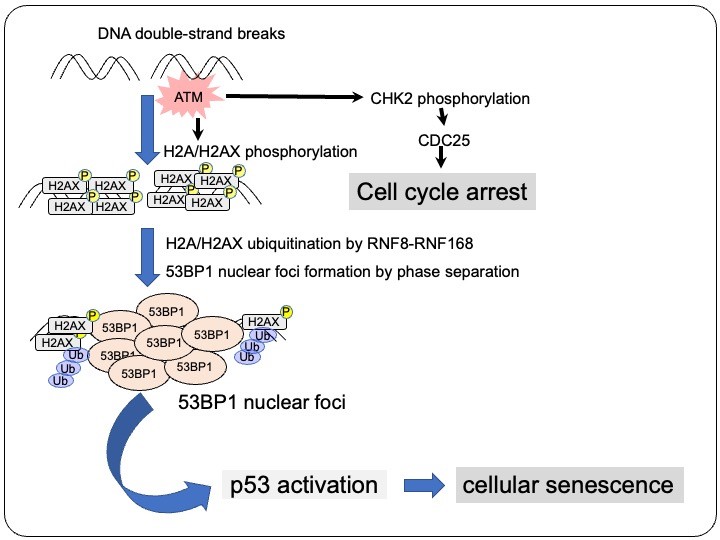Tsukasa Oda1, *, Nanami Gotoh2, Tetsuhiro Kasamatsu2, Hiroshi Handa3, Takayuki Saitoh2, Nobuo Sasaki1 1 Laboratory of Mucosal Ecosystem Design, The Institute for Molecular and Cellular Regulation, Gunma University, Maebashi, Gunma 371-8512, Japan 2 Graduate School of Health Sciences, Gunma University, Maebashi, Gunma 371-8514, Japan 3 Graduate School of Medicine, Gunma University, Maebashi, Gunma 371-8511, Japan *Corresponding author
About
Cellular senescence is linked to a wide range of age-related diseases and can be triggered by a variety of stresses, including DNA damage. A variety of genotoxic stressors, such as anti-cancer drugs, cause DNA double-strand breaks (DSBs), which trigger the accumulation of the tumour suppressor protein p53 in the nucleus. Cellular stresses stabilize and activate the p53 signalling pathway, which regulates various cellular processes, such as apoptosis, DNA repair, and senescence. Although p53 signalling is a well-known tumour suppressor pathway, it remains unclear how it is regulated during cellular senescence. Here, we show that p53-binding protein 1 (53BP1) accumulation in the nuclear foci is required for DNA damage-induced cellular senescence via p53 activation. In human immortalized fibroblast, shRNA-mediated 53BP1 depletion decreased not only the expression of p53-target genes but also the cellular senescence induced by adriamycin treatment. Furthermore, we confirmed that DSBs trigger the hyperaccumulation of 53BP1 in the nuclear foci, which plays a key role in the regulation of cellular senescence. To prevent the accumulation of 53BP1 in the nuclear foci, we used phase separation inhibitors, and siRNA against RNF168, which accumulates at DSB loci and forms complexes with 53BP1. This blocks the formation of 53BP1 nuclear foci and DNA damage-induced cellular senescence by activating the p53 signaling pathway. In conclusion, we demonstrated that increased accumulation of 53BP1 in the nuclear foci following DNA damage activates p53 and governs cellular senescence via a liquid–liquid phase separation mechanism.
Paper information
"DNA damage-induced cellular senescence is regulated by 53BP1 accumulation in the nuclear foci and phase separation"
Tsukasa Oda, Nanami Gotoh, Tetsuhiro Kasamatsu, Hiroshi Handa, Takayuki Saitoh, Nobuo Sasaki
Cell Proliferation (Wiley Online Library)
Online URL
https://onlinelibrary.wiley.com/doi/full/10.1111/cpr.13398








